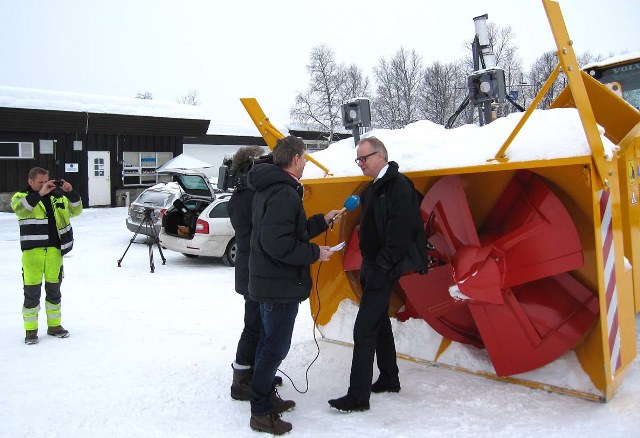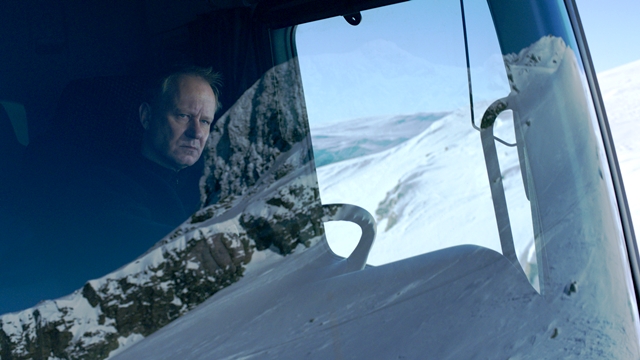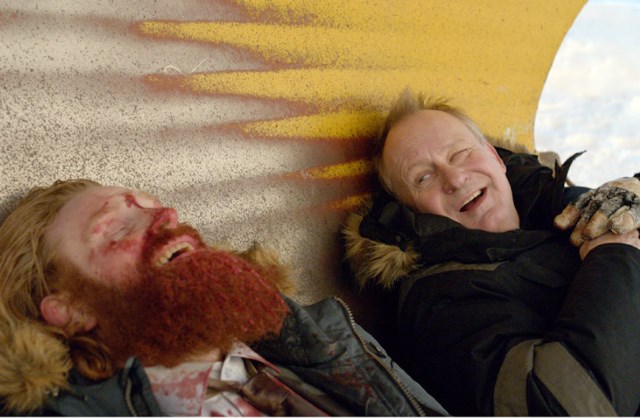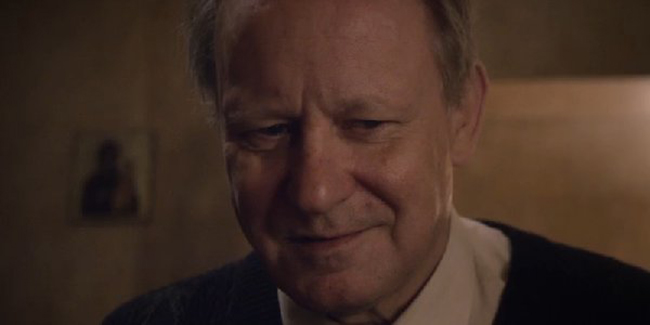“Haven’t we met before?” We hadn’t, but Stellan Skarsgård’s friendly greeting immediately sets the tone for an encounter which is so relaxed that thoughts of the explosive Nils, the quiet man who boils over in In Order of Disappearance, almost evaporate. How did this affable, chatty and thoughtful Swede become a man who kills repeatedly and so gruesomely on screen?
Balancing this with his role as a world-weary banker in the recent Hector and the Search for Happiness and, less-recently as possible-dad Bill in the Mamma Mia! film as well as his recurrent portrayal of Dr. Erik Selvig in the Thor and Avengers films, it’s apparent that Skarsgård isn't an actor who sticks to one type of role. In person, it transpires, his outlook is as diverse as the many styles of films he appears in. The conversation of course takes in In Order of Disappearance, but also what it is to be Scandinavian, the spread of violence throughout the world, Lars von Trier and surprising references to Monty Python.
In London to promote In Order of Disappearance, he is brim-full of energy, looks younger than his 63 years, is snappily dressed (nicely cut purple trousers and a dapper striped blue shirt) and radiates a healthy glow. He has a spring in his step.
 As well he should. He is one of Sweden's most succesful exports. Although he was first seen in an American film in the mid-Eighties, international recognition really came with 1990’s The Hunt for Red October. In 1996, with Breaking the Waves, he began a long association with Denmark’s Lars von Trier. Skarsgård balances the mainstream with the art-house. (Pictured right, Stellan Skarsgård takes time out to meet the press while filming In Order of Disappearance.)
As well he should. He is one of Sweden's most succesful exports. Although he was first seen in an American film in the mid-Eighties, international recognition really came with 1990’s The Hunt for Red October. In 1996, with Breaking the Waves, he began a long association with Denmark’s Lars von Trier. Skarsgård balances the mainstream with the art-house. (Pictured right, Stellan Skarsgård takes time out to meet the press while filming In Order of Disappearance.)
Hans Petter Molland, the Norwegian director of In Order of Disappearance, is another long-term collaborator. They first worked together on 1995’s Zero Kelvin. In Order of Disappearance is their fourth film and follows 2010’s A Somewhat Gentle Man, which also told the story of a quiet man pushed beyond the brink.
Filmed in Norway's snowy north, In Order of Disappearance casts Skarsgård as Nils, a Swedish-born, Norway-dwelling snow plough driver who, after his son dies, is pitched into an underworld where competing drug gangs don’t – initially – know that he is the source of their new woes. The boss of one of the gangs, of transplanted Serbs, is played by Bruno Ganz. Evidently, whatever its level of violence and dark undertone, Skarsgård had a ball making the film. He seems to have a ball making every film.
 KIERON TYLER: What was driving the snow plough like?
KIERON TYLER: What was driving the snow plough like?
STELLAN SKARSGÅRD: I actually learnt to drive it and had a lot of fun doing it. It was fantastic. But the conditions were very hard, we had temperatures down to minus 28 degrees. You can see in some shots where faces can’t properly move. It was horrible conditions to shoot under. I’m such a city boy, an indoor person. I do very well with a glass of wine in front of the fireplace. (Pictured left, taking the wheel of the snow plough in In Order of Disappearance.)
What do you make of the contrast between Nils as an archetypal quiet Swede and the revenge-fuelled obsessive he becomes?
Scandinavia has been a very peaceful corner of the world for quite a while. Sweden, for example, hasn’t been to war for 200 years. Norway has been occupied, but that wasn’t their fault – Germany had its own ideas about how to run the world. It’s not a very violent culture in Scandinavia and it’s interesting with Nils is what happens when you don’t have the tools to handle a devastating situation that’s emotionally very challenging. You lose your child, you can’t communicate with your wife. Out comes the very primitive reaction. The veneer of civilisation just falls away, even if it’s as thick as the Swedish or Scandinavian veneer. Out comes the caveman. That is something we should be aware we are capable of. Yugoslavia was a much civilised country and then suddenly it fell apart and incredible brutality erupted. We are capable of horrendous actions.
Does the lawlessness going on under the surface in In Order of Disappearance reflect anything real?
With Scandinavia in general, crime has changed in all of our countries. Crime is globalised nowadays and we are becoming more and more part of the world. Until [Swedish Prime Minister] Olof Palme was shot [in 1986], our Prime Minister walked the streets like anyone else. The violence of the world has finally arrived in the secluded paradise that Scandinavia was. It is a different society to what it was 30 years ago, in Norway as well.
 In Order of Disappearance’s humour is in the darkest places…
In Order of Disappearance’s humour is in the darkest places…
I like it. I don’t think the violence that Nils is executing is justified. I’m against capital punishment and revenge especially. Morally you have to condemn Nils even if you understand him. But I find that humour is very close to fear. Take Monty Python and the Holy Grail: somebody chops off the arms of this guy and he stills wants to fight. It’s very funny. The brutality of it makes it even funnier. It is horrible but comedy negates the horror of it. There’s a feeling of hilarious freedom. It’s also good if you don't know how to react to what you see. (Pictured right, a shared moment of humour before Stellan Skarsgård's Nils deals with one of his victims in In Order of Disappearance.)
You haven’t appeared together in a film before, is this your first encounter with Bruno Ganz?
I’d met him briefly before at an European Film Academy event. I’ve always thought he is a fantastic actor. Unfortunately, we don’t have much to do with each other in the film. But I knew Nils Petter wanted to have me and Bruno Ganz in a car together at the end of the film, it was a dream of his.
 This is your fourth film with Hans Petter Moland, what keeps you coming back?
This is your fourth film with Hans Petter Moland, what keeps you coming back?
We’ve developed not only a great friendship but our collaboration is almost shorthand, we have a lot of fun together. You have a few people you work with where you work with them again and work doesn't seem to be work. It’s more playing in the sandbox – it makes you braver. It started with Zero Kelvin which we shot in the Arctic, in Svalbard. It’s so fantastic, so beautiful up there but so dangerous (polar bears roam freely). Hans Petter is the outdoor man, he puts on his skis, follows the reindeer over the mountain for three days, slays it and carries it back. I don’t do that kind of stuff. We are very different. But we meet in a place of work. And I know what he’s good at and what he wants, and he knows what I’m good at so it’s always back and forth. We did well with A Somewhat Gentle Man and In Order of Disappearance is the continuation of investigating the possibility of humour and taking it in different directions – being violent, disgustingly violent. And funny at the same time. (Pictured left, Stellan Skarsgård in Hans Petter Moland's A Somewhat Gentle Man.)
You produced and appeared in King of Devil’s Island, which dealt with a difficult episode in Norwegian history. Do you have an affinity for Norway?
They have good filmmakers in Norway, I have friends there. I think I’ve done one Swedish film in 20 years. There are differences in culture between Sweden and Norway. There was a survey of CEOs of big corporations in different countries and in Sweden 80% of the CEOs said it was very important for you to have humility and be humble. In Norway 20% said it was good to be humble and have humility. They are very different cultures. Norway broke loose from Sweden in 1905 and they are terribly nationalistic. In Sweden we haven’t had any invaders since 1500-and-something so we are more secure. The first time I came to Norway in the late Sixties it was a very poor country and very religious – Norway was one of the few countries which totally banned Monty Python's Life of Brian.
 As well as Hans Petter Moland, you’ve also worked regularly with Lars von Trier, most recently in Nymphomaniac. What’s that relationship like?
As well as Hans Petter Moland, you’ve also worked regularly with Lars von Trier, most recently in Nymphomaniac. What’s that relationship like?
Just as with Hans Petter, we are very good friends although they are different personalities. Lars is hyper-intelligent, hyper-sensitive and extremely funny. A very good person. Also, to a certain extent, childish. If you look at all his films, they are fairy tales, the dialogue has a nursery quality. He often asks you to improvise and it's very hard as the dialogue he likes is so childish. He’s very direct and says everything he thinks, which can hurt people of course. But you can say everything you think to him too, so it’s a very open relationship we have. I’d work with him any time, the working process is so much fun. Really pleasant. The most unhierarchical set you can be on. The runner can come up to Lars and say "that’s a stupid idea". He’s really generous, you have absolute freedom to try what you want. You can’t be on a better set.(Pictured right, Stellan Skarsgård in Lars von Trier's Nymphomaniac.)
You make films which are historical-set fantasies – say Pirates of the Caribbean – and films set in the gritty world of today. Which do you prefer, real-life settings or the fantasy?
My favourite film as a kid was Les enfants du paradis which is a melodramatic fantasy. I like the big strokes of the melodrama. Breaking the Waves is melodrama. But I like the big strokes as long as they are tuned in to real life, so they can become grounded. Life can be melodramatic, but you don't have to play it that way. You like it to be about real people. It really does matter if it has a human truth to it. Elem Klimov’s film Come and See is about this boy in the Second World War and is extremely brutal and extremely hard to watch but beautiful because of the real life. With Kenneth Branagh's Cinderella (released next year), that’s a fairy tale. Kenneth is doing the right thing, not trying to do a dark version of the Cinderella story, so it’s like Breaking the Waves – it’s a film about a really good girl. There is a human truth I want, whether it’s a fantasy film or a kitchen sink drama. But I cannot say there is a specific genre I prefer.
You make a lot of films. Do you think you’ll ever burn out?
I do make a lot. I like it. I thrive on working.
In Order of Disappearance is in cinemas now
Read theartsdesk review of In Order of Disappearance
Overleaf: watch the trailer for In Order of Disappearance
Watch the trailer for In Order of Disappearance














Add comment